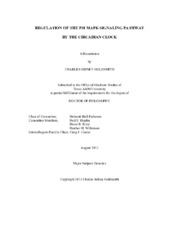Regulation of the p38 MAPK Signaling Pathway by the Circadian Clock
Abstract
Mitogen activated protein kinase (MAPK) pathways are conserved biochemical signal transduction pathways in eukaryotic organisms. These signaling pathways demonstrate great versatility in their ability to detect various environmental stimuli and direct an appropriate cellular response. The circadian clock is a timekeeping mechanism that temporally coordinates diverse biological functions in an organism with the environment. Thus, it is not surprising that MAPK pathways have been utilized by the circadian clock to regulate many essential functions. Due to the conserved nature of circadian clocks and MAPK signaling pathways in eukaryotes, it is possible to develop hypotheses in simple model organisms, such as the fungus Neurospora, that are relevant to more complex organisms.
The OS-2 MAPK pathway in the filamentous fungus Neurospora is rhythmically activated by the circadian clock. In order to generate this rhythmic signal, the circadian oscillator directly regulates the rhythmic transcription of the os-4 MAPKKK and histidine phosphotransferase hpt-1, which are upstream regulators of the OS-2 MAPK. Also, the circadian rhythm in MAPK activation produces a more robust stress response during the time of the day that stress is most likely to be encountered. Based on these data, a model for the clock regulation of MAPK activation is presented, and a biological significance is assigned to the rhythms in this pathway.
Informed by these findings in Neurospora, the related p38 MAPK pathway was studied in mammalian cell lines that represent functionally distinct tissues in regards to clock function. A rhythm in p38 MAPK activation was observed in cells derived from the suprachiasmatic nucleus and fibroblasts of a mouse, the master pacemaker and a peripheral tissue, respectively. In cells that lacked a functional circadian oscillator, the rhythm in p38 activation was absent, and overall levels of p38 protein were lower. These data demonstrate a circadian clock-dependent oscillation in p38 activity.
These studies provide a basis to understand how the circadian clock generates endogenous rhythms in MAPK signal transduction pathways. Also, the characterization of clock-regulated stress response pathways provides an understanding of the adaptive advantage of the circadian clock.
Citation
Goldsmith, Charles Sidney (2013). Regulation of the p38 MAPK Signaling Pathway by the Circadian Clock. Doctoral dissertation, Texas A & M University. Available electronically from https : / /hdl .handle .net /1969 .1 /151390.


